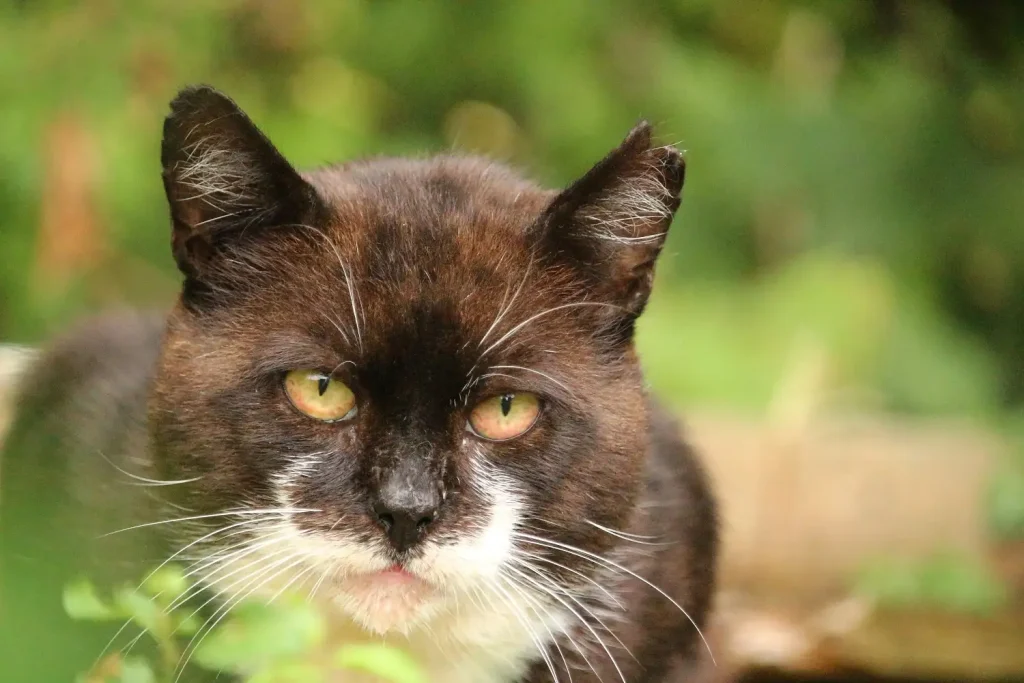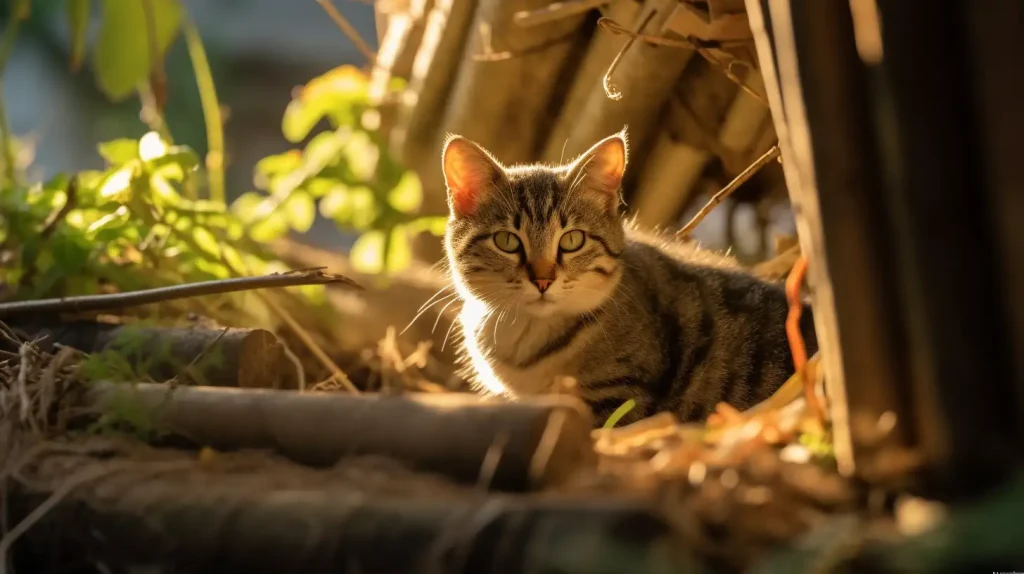Table of Contents
Key Takeaways
- Why do stray cats have clipped ears? Stray cats with clipped ears are often part of Trap-Neuter-Return (TNR) programs, where cats are caught, neutered, and returned to their environment.
- TNR programs help control the stray cat population while improving their overall health and reducing certain diseases.
- Neutering can lead to behavioral changes, such as reduced roaming, yowling, and marking territories.
- Neutered cats may live longer, healthier lives as a result of the procedure.
- Veterinary professionals play a crucial role in TNR programs, providing humane trapping, neutering, and care.
- Advanced data collection, community involvement, and education can enhance the effectiveness of TNR efforts.
- GPS tracking and machine learning can identify high-density cat populations for targeted TNR initiatives.
- Increasing awareness and understanding of TNR within communities fosters acceptance and active participation.
There’s something quite curious you might have noticed while strolling through your neighborhood – stray cats with clipped ears. You may wonder why these cats, seemingly robust and self-sufficient, sport this peculiar “style.” This article aims to unpack this mystery and shed light on the intriguing world of feline welfare.
Understanding Stray and Feral Cats
In order to grasp the concept of clipped ears, it’s essential to understand the differences between stray and feral cats.
Stray cats are often pets that have been lost or abandoned, still accustomed to human interaction and care. Feral cats, on the other hand, are usually born in the wild and have limited to no experience with humans, making them more wary and independent.
The population and distribution of stray and feral cats vary globally, but they are a common sight in many regions, from urban cities to rural landscapes. These felines significantly impact both the environment, through predation and competition with local wildlife, and public health, through the potential spread of zoonotic diseases.
Trap-Neuter-Return Program
One humane method to manage and control the growing stray and feral cat population is through the Trap-Neuter-Return (TNR) program.
The TNR program is a method of humanely trapping stray and feral cats, getting them neutered (or spayed), and then returning them to their environment. This procedure not only prevents overpopulation but also curbs aggressive behaviors linked with mating and breeding.
Implemented across various parts of the world, the TNR program has proven effective in stabilizing and gradually reducing stray and feral cat populations. However, it’s not without its share of controversies and criticisms. Some argue that returning the cats to the wild could still impact the local fauna adversely. Others question the ethics of returning neutered cats into a harsh environment where food and safety aren’t guaranteed.
Historical Context of the TNR Program
Imagine a time before we understood the full impact of growing stray and feral cat populations. Concerns for both the welfare of these cats and their impact on the environment were growing. Something needed to be done, and thus, the TNR program was born.
The idea originated in the 1950s in the United Kingdom, where it was called “trap and return.” In the following decades, other countries, particularly the United States, adopted and modified the strategy. The essential addition was neutering – or spaying – the cats before returning them to their environment, turning the program into what we now call TNR.
Initially, the concept faced resistance. Skeptics doubted its effectiveness, fearing it might even exacerbate the problem. Some saw the returning of the cats to the outdoors as inhumane, given the challenges of a street life. But the biggest hurdle was logistics – executing a large-scale program required significant resources and cooperation between animal welfare organizations and the community.
Over time, however, TNR has proven to be a valuable method. Today, it is recognized and implemented worldwide, often supported by local legislation. It’s a testament to our ability to come together and find solutions that respect the delicate balance of our shared environment. Despite the challenges, the evolution of the TNR program shows that when we apply empathy, science, and community spirit, we can change the narrative for stray and feral cats, one neutered, ear-tipped feline at a time.
Physical and Behavioral Changes in Cats after Neutering
Neutering a cat, a procedure removing their reproductive organs, can lead to some observable changes in both their physical health and behavior. Now, before you gasp in worry, let’s unravel this mystery together.
Firstly, neutered cats are often less prone to certain diseases such as feline immunodeficiency virus (FIV) and feline leukemia virus (FeLV), primarily transmitted through deep bite wounds, a common occurrence in mating fights. So, in a way, neutering can be seen as a preventative health measure!
When it comes to behavior, say goodbye to the midnight serenades under your window, as neutered cats typically lose their urge to mate, and thus, reduce related behaviors such as yowling, marking territories, and the restless urge to roam.
Despite some common misconceptions, neutering doesn’t make your cat lazy or obese. However, their metabolism might slow down a bit, and they might not need as much food as before. So, keep an eye on their diet and make sure they get plenty of playtime to keep those extra pounds at bay.
In terms of lifespan, it’s like hitting a jackpot! Studies suggest that neutered cats often live longer, healthier lives. In a nutshell, neutering is not just about controlling the stray cat population; it’s also about improving the overall quality of a cat’s life. So, the next time you see a cat with a clipped ear, remember, it’s not just a fashion statement but a sign of a potentially healthier and safer life.
Legal and Ethical Considerations of the TNR Program and Ear Tipping
Navigating the legal landscape and ethical conundrums of the TNR program and ear tipping is a bit like herding cats – challenging, but certainly not impossible. Different regions worldwide approach these practices with varying degrees of acceptance and legislation, adding another layer of complexity to this issue.
In some places, TNR programs are fully endorsed and supported by local governments, seen as a compassionate and effective means to manage feral and stray cat populations. In contrast, other regions either lack the legal frameworks to implement such initiatives or outright consider them illegal, viewing them as potential contributors to ecological imbalance and public health risks.
The act of ear tipping, while a recognized global symbol indicating a neutered feral cat, has its own ethical discussions. On one hand, it’s hailed as a painless, practical, and essential part of TNR practices. Yet, it also raises questions about the extent to which humans should intervene in the lives of these felines, especially considering that these cats will return to a life in the wild post-surgery.
These diverse perspectives underline the importance of ongoing dialogue and research in seeking a balanced, universally accepted approach towards TNR programs and ear tipping. After all, the ultimate goal we all share is to ensure the welfare and humane treatment of our feline friends while balancing the concerns of ecosystems and communities alike.
Involvement of Veterinary Professionals in TNR
If you’ve ever wondered who’s behind the seemingly simple act of ear tipping and returning stray cats to their environment, the answer lies with the dedicated team of veterinary professionals. These unsung heroes are the backbone of the TNR program. Veterinarians and veterinary nurses play a pivotal role, from the delicate act of humanely trapping these cats, to performing the neutering procedures, ear tipping, and finally, ensuring their safe return to their familiar surroundings.
Veterinary professionals engaged in TNR programs often undergo specific training, equipping them with the skills necessary to handle the unique challenges of dealing with stray and feral cats. This includes mastering techniques for minimally stressful handling, anesthesia, surgery, and post-operative care that caters to the unique needs of this population.
The challenges these professionals face are multifaceted. On the one hand, they grapple with the physical challenges of treating often nervous and scared animals. On the other hand, they face the emotional burden of knowing the harsh reality these animals often return to. Furthermore, there’s always the struggle for resources and funding, as TNR programs, often non-profit, are continually battling financial constraints.
Yet, despite these challenges, the tireless dedication of these professionals has been instrumental in controlling the stray and feral cat population, contributing significantly to animal welfare and public health. By understanding their role, we can better appreciate the clipped ears of stray cats and the immense effort that goes into that small sign.

Ear Tipping: The Universal Symbol
In the world of feline welfare, ear tipping, or ear clipping, plays a crucial role.
Ear tipping is the removal of a small portion (typically the top one-fourth) of a cat’s left ear while the cat is under anesthesia for neutering. This procedure is painless for the cat and provides a lasting, visible sign that the cat has been part of a TNR program.
Ear tipping is essential because it immediately informs animal control officers, shelter workers, and the public that this particular feline has already been neutered. This saves the cat from unnecessary re-trapping and potential re-surgery. Despite its apparent oddity, ear tipping is a humane and efficient way to keep track of neutered feral and stray cats.
Other Identification Methods for Stray/Feral Cats
While ear tipping is the most globally recognized identification method for neutered feral and stray cats, there are indeed other alternatives worth considering, including collars and microchips. Each of these methods has its advantages and disadvantages and their feasibility varies across different regions and contexts.
Collars
Collars are easily visible and can carry essential information like the cat’s name, caretaker’s contact information, or even a notice that the cat is part of a TNR program. This immediate visibility can be a huge advantage, especially in residential areas where people may be unaware of what a tipped ear signifies.
However, collars also have a few drawbacks. Firstly, they can be a safety hazard. Cats are explorers and can get their collars snagged on branches, fences, or other objects, leading to possible injury. This risk led to the creation of “breakaway” collars designed to snap open under pressure, but even these can still pose a risk in certain scenarios.
Secondly, collars can be lost, rendering them ineffective as a long-term identification method. Finally, in some cultural contexts or regions, a collared stray cat might be mistaken for a lost pet, leading to confusion and potential mismanagement of the cat.
Microchips
Microchipping is a more technologically advanced method of identification. A microchip, about the size of a grain of rice, is inserted under the cat’s skin, usually between the shoulder blades. Each microchip carries a unique identification number, and when a special scanner is passed over it, the number can be read and linked to the owner’s or caretaker’s information in a database.
Microchips offer a permanent, safe, and unalterable method of identification. Unlike collars, they can’t fall off or get lost, and they pose no physical risk to the cat.
The downside, however, is that detecting a microchip requires a special scanner, which not all individuals or even animal control officers may have on hand. This makes microchipping less effective for quick identification in the field. Additionally, microchipping requires maintaining up-to-date databases, which may not always be feasible in areas with limited resources or in countries without established animal control infrastructure.
Ear Tipping
Despite the alternatives, ear tipping remains the preferred method of marking stray and feral cats. It’s a safe, permanent, and immediately visible way to identify a neutered cat, and it doesn’t require any special equipment or technology to recognize.
One of the main drawbacks of ear tipping is that it’s not universally recognized, and untrained individuals may misinterpret it as a sign of injury or cruelty. Therefore, public awareness and education campaigns are vital wherever TNR programs are in place.
Each of these identification methods has its place and can be chosen based on the specific needs, resources, and cultural context of different regions. Ultimately, the goal is to ensure the welfare of stray and feral cats while managing their populations effectively and humanely.

How the Public Can Help
As an everyday citizen, there are various ways you can help support the welfare of stray and feral cats.
Adopting or fostering a stray cat is one of the most direct ways to help. These cats often make great companions and are in dire need of loving homes. Encouraging responsible pet ownership is also crucial, as this can prevent pet abandonment and the subsequent increase in stray populations.
Supporting your local TNR programs and shelters through donations or volunteering is another way to contribute. These organizations often operate on limited resources and can use all the help they can get.
Finally, understanding the significance of a cat with a clipped ear and explaining it to others can go a long way in promoting the welfare of these misunderstood felines.
Strategies for Community Engagement and Education
Effective control and welfare of stray and feral cat populations is not just a task for animal welfare organizations, but also requires active participation from the community. Here’s how we can involve communities in the care of these silent members of our neighborhoods, and the benefits of doing so.
Educating the Community about TNR
Awareness is the first step towards change. By providing accurate information about the Trap-Neuter-Return program, we can help people understand its purpose and importance. Educational sessions, brochures, social media campaigns, and community meetings can all be used to communicate the benefits of TNR – from stabilizing cat populations and reducing nuisance behaviors, to improving the overall health of the cats.
Involving the Community in TNR Efforts
Active involvement in TNR efforts can range from simple actions like reporting the presence of stray or feral cats to local animal welfare organizations, to more hands-on activities like volunteering for trapping and post-surgery care. Community members can also play a crucial role in monitoring released cats and providing food and shelter.
Promoting Responsible Pet Ownership
Promoting responsible pet ownership can help to reduce the number of unwanted cats that end up on the streets. This includes advocating for spaying and neutering of pet cats, discouraging abandonment, and supporting adoption over purchasing cats.
Youth Education
Schools can play an important role in promoting feline welfare. By integrating topics related to pet ownership, animal welfare, and the TNR program in their curriculum, young minds can be groomed to become responsible and compassionate future pet owners and community members.
By adopting these strategies, communities can transform from mere spectators to active participants in the welfare of stray and feral cats, resulting in a win-win situation for both the cats and the community.
Future Prospects and Improvements for TNR Programs
Advancements in Technology and Procedures
Looking into the future, the evolution of TNR programs holds great promise. One area of advancement lies in the development of new technologies and procedures. Researchers are exploring non-surgical sterilization methods, such as the use of immunocontraceptive vaccines, to control feral cat populations. If successful, this could provide an even more humane and less invasive alternative to traditional neutering, reducing the risks and recovery time associated with surgery.
Data Collection and Analysis
Moreover, the adoption of more advanced data collection and analysis methods could greatly improve the efficacy of TNR programs. GPS tracking and machine learning algorithms could help identify high-density cat populations and their movement patterns, allowing for more targeted and efficient TNR efforts.
Community Involvement and Education
Community engagement is another area with immense potential for growth. Increasing awareness and understanding about the importance of TNR within communities can lead to wider acceptance and more active participation. Digital platforms and social media are proving instrumental in this endeavor, allowing for the spread of information and the organization of local TNR events more easily and effectively.
Policy Changes
The future of TNR also hinges on changes at the policy level. Advocacy for more humane laws regarding the management of stray and feral cats can ensure the wider implementation of TNR programs.
The road ahead for TNR programs is exciting and full of possibilities. As we continue to innovate and refine these programs, we move closer to a world where every cat—pet, stray, or feral—lives a life of dignity and respect.
Why Do Stray Cats Have Clipped Ears – Conclusion
Navigating the legal and ethical considerations of the TNR program and ear tipping requires careful attention. This compassionate approach to stray cat management not only controls population but improves their overall quality of life. The adoption of advanced data collection, community involvement, and education efforts can further enhance the effectiveness and acceptance of TNR. Let us strive to be responsible citizens, promoting awareness and working together to create a better world for our feline friends.
FAQs
Q: What does it mean when a stray cat has a clipped ear?
A: A clipped ear in a stray cat, usually the left one, signifies that the cat has been trapped, neutered (or spayed), and then returned to its environment. This is part of a worldwide program called Trap-Neuter-Return (TNR), aimed at managing and controlling the population of stray and feral cats in a humane way.
Q: Is ear tipping painful for the cat?
A: No, ear tipping is not painful for the cat. The process is done under anesthesia at the same time the cat is neutered or spayed. The cat does not experience any pain during the procedure and there are typically no long-term effects.
Q: What’s the difference between a stray cat and a feral cat?
A: A stray cat is often a pet that has been lost or abandoned, still accustomed to human interaction and care. A feral cat, on the other hand, usually has limited to no experience with humans, making them more wary and independent.
Q: Why do we need to neuter stray and feral cats?
A: Neutering helps control the population of stray and feral cats, reducing the number of kittens born into the hard life of a stray cat. It also decreases aggressive behaviors related to mating, leading to a safer and healthier cat community.
Q: Are there other ways to mark a neutered cat, apart from ear tipping?
A: Yes, there are other ways to mark neutered cats such as collars and microchips. However, collars can potentially endanger the cat as they might get caught on various objects. Microchips require special readers to detect, making them less practical for quick identification in the field. Hence, ear tipping is usually the preferred method.
Q: Can I help with the TNR program in my community?
A: Yes, you can definitely help. You can volunteer with local organizations that carry out TNR programs, help educate others about the importance of TNR, or even learn how to safely trap cats for the program yourself. Donations to local TNR programs are also usually greatly appreciated.
Q: What should I do if I see a cat with a clipped ear?
A: If you see a cat with a clipped ear, there’s usually no need for intervention as the cat has already been neutered and is being managed as part of a TNR program. However, if the cat appears to be sick or injured, you should contact a local animal rescue organization.



